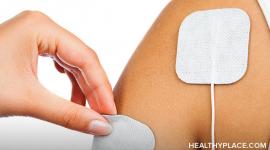Bowen Therapy for Psychiatric Disorders
Bowen Therapy is a light touch therapy that may help with the treatment of psychiatric disorders and job-related stress. Learn more.
Before engaging in any complementary medical technique, you should be aware that many of these techniques have not been evaluated in scientific studies. Often, only limited information is available about their safety and effectiveness. Each state and each discipline has its own rules about whether practitioners are required to be professionally licensed. If you plan to visit a practitioner, it is recommended that you choose one who is licensed by a recognized national organization and who abides by the organization's standards. It is always best to speak with your primary health care provider before starting any new therapeutic technique.
Background
Bowen therapy, also known as Bowen treatment, is a technique that involves gentle but precise soft tissue manipulation. Bowen therapists use their thumbs or fingers to make subtle rolling maneuvers. Bowen therapy aims to trigger a response from the body rather than to physically alter the body. Only minimal force is thought to be necessary.
In general, Bowen therapy does not aim to fix specific health problems, but rather to help the body reach a more harmonious state in which it can better cure itself. Short-term benefits are said to include a sense of relaxation. Longer-term effects may include better overall well-being or improvements in disease states.
Bowen sessions may last from 30 to 90 minutes and are often customized to the individual. Sessions are usually spaced several days apart, and three or four sessions may be recommended initially. During a Bowen session, practitioners occasionally leave the treatment room, with the aim to allow the patient's body to absorb messages that have been transmitted by the practitioner via bodywork. Many Bowen practitioners see this approach as being complementary to other medical treatments, such as prescription drugs or surgery, rather than as a replacement for other treatments.
This technique was originally developed in the 1960s by Thomas Bowen, an Australian, based on his sense of what types of bodywork would be effective for good health, rather than on any particular scientific theory or finding. The approach was initially developed to treat musculoskeletal disorders, but was later expanded to treat other health conditions such as asthma. The technique is most commonly used in Australia, but it has recently gained popularity in England and North America.
In recent years, several practitioners and instructors have developed training courses specifically for small animals.
Theory
A number of mechanisms of action have been proposed for Bowen therapy. It has been suggested that Bowen therapy may correct faulty vibrational frequencies in the body and establish more favorable overall balance, improve connections between the nervous system and brain, improve connections between different body systems and facilitate overall harmony of the body. Scientific study is limited in this area.
Evidence
Scientists have studied Bowen therapy for the following health problems:
Frozen shoulder
Preliminary research reports that Bowen therapy may improve range of motion in patients with frozen shoulder. Additional studies are needed before a firm conclusion can be drawn.
Unproven Uses
Bowen therapy has been suggested for many other uses, based on tradition or on scientific theories. However, these uses have not been thoroughly studied in humans, and there is limited scientific evidence about safety or effectiveness. Some of these suggested uses are for conditions that are potentially life-threatening. Consult with a health care provider before using Bowen therapy for any use.
| Addiction Allergies Anorexia Anxiety Arthritis pain Asthma Attention-deficit hyperactivity disorder Back pain Bedwetting Bunions Cardiovascular problems Carpal tunnel syndrome Chronic fatigue syndrome Colic in infants Constipation Diarrhea Difficulty conceiving children Digestion problems Fibromyalgia General well-being Groin pain Gynecological issues Hammertoes Hamstring pain Headache Hernia Hormonal disorders | Indigestion Infertility Insomnia Jaw pain/misalignment Knee pain Learning disabilities Lung diseases Menopausal symptoms Menstrual disorders Migraine headache Muscle pain Musculoskeletal problems Neck pain Plantar fasciitis Premenstrual syndrome Reflux Respiratory problems Sciatica, sacro-iliac pain Scoliosis Shin splints Sporting injuries Sprained ankles Sternal pain, spring ribs Stress Stroke rehabilitation Tennis elbow |
Potential Dangers
Bowen therapy is a minimally invasive technique, and is generally believed to be safe in most individuals. Safety has not been thoroughly assessed scientifically. Bowen therapy should not be used for severe conditions in place of more proven treatments. Some Bowen technique practitioners recommend that the "Coccyx Procedure" be avoided in pregnant women, the "TMJ Procedure" be avoided in people whose jaws have been surgically altered at the condyles, and that the "Breast Tenderness Procedure" not be performed on women with breast implants.
Summary
Bowen therapy involves gentle but precise soft tissue manipulation. Early evidence suggests possible benefits in the treatment of frozen shoulder, psychiatric disorders and job-related stress. Further study is warranted in these areas. Bowen therapy has not been well studied for any other condition. Bowen therapy should not be used for severe conditions in place of more proven treatments. Speak with a qualified health care provider if you are considering Bowen therapy.
The information in this monograph was prepared by the professional staff at Natural Standard, based on thorough systematic review of scientific evidence. The material was reviewed by the Faculty of the Harvard Medical School with final editing approved by Natural Standard.
Resources
- Natural Standard: An organization that produces scientifically based reviews of complementary and alternative medicine (CAM) topics
- National Center for Complementary and Alternative Medicine (NCCAM): A division of the U.S. Department of Health & Human Services dedicated to research
Selected Scientific Studies: Bowen Therapy
Natural Standard reviewed more than 40 articles to prepare the professional monograph from which this version was created.
Some of the more recent studies are listed below:
- Carter B. A pilot study to evaluate the effectiveness of Bowen technique in the management of clients with frozen shoulder. Complement Ther Med 2001;Dec, 9(4):208-215.
- Carter B. Clients' experience of frozen shoulder and its treatment with Bowen technique. Complementary Therapies in Nursing 7 Midwifery 2002;8(4):204-210.
- Long L, Huntley A, Ernst E. Which complementary and alternative therapies benefit which conditions? A survey of the opinions of 223 professional organizations. Complement Ther Med 2001;Sep, 9(3):178-185.
back to: Alternative Medicine Home ~ Alternative Medicine Treatments
APA Reference
Staff, H.
(2008, November 24). Bowen Therapy for Psychiatric Disorders, HealthyPlace. Retrieved
on 2025, November 23 from https://www.healthyplace.com/alternative-mental-health/treatments/bowen-therapy-for-psychiatric-disorders

